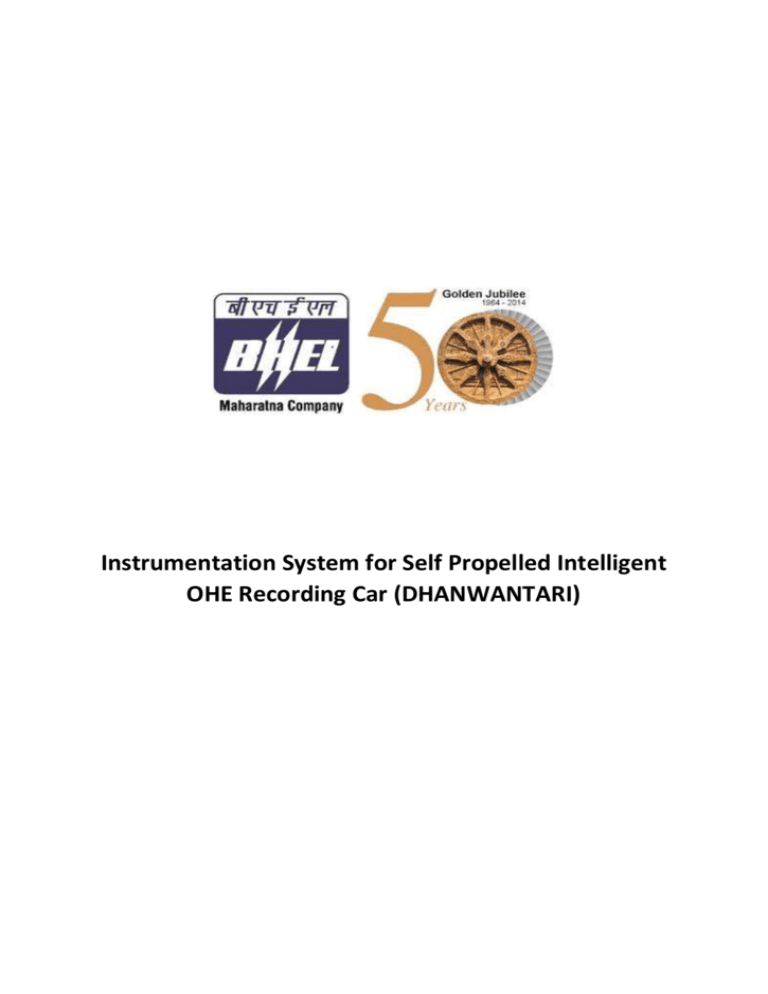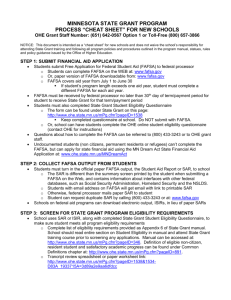spec-for-eoi
advertisement

Instrumentation System for Self Propelled Intelligent OHE Recording Car (DHANWANTARI) Introduction: Indian Railway has floated a global tender RE(S)/11/2013/0001(DEITC)/7/1 for Design, Manufacture, Development, Supply, Testing & Commissioning of Self-Propelled Intelligent OHE Recording Car (DHANWANTARI) (8- Wheeler Diesel Electric Under Slung Type) for Operation on Broad Gauge (1676 mm) Electrified (25 KV A.C.) Routes of Indian Railways. The 8-Wheeler Intelligent Inspection & Maintenance cum OHE recording Car is a self-propelled 4-axle vehicle and is used for periodical inspection, measuring and recording the OHE parameters. The 8 Wheeler Inspection & Intelligent OHE recording car uses the power generated by the Diesel Alternator set provided under slung for propulsion and not the power from live OHE. For measurement & recording of OHE parameters a sophisticated Instrumentation system is required. This specification pertains to supply, testing & commissioning of complete system on 8-wheeler selfpropelled intelligent OHE car. Eligibility Criteria: For supply of the instrumentation system the eligibility criteria shall be as illustrated below: Bidder must have supplied similar type of instrumentation system for measuring/recording of OHE parameters & must have the satisfactory performance from user Railway(s) for at least one number of such Measuring instruments for a minimum period of two years on the date of tender opening. Description of Instrumentation System & Parameters to be measured:The Intelligent OHE recording car shall be self-contained and completely equipped with all Measuring/Recording facility and there shall be no dependence on external source. The instrumentation shall be able to measure & record the parameters in the speed range of 0-110 kmph when running in self-propelled mode and in the speed range 0 – 110 kmph when coupled to a train. The measurements shall be made under live or non-live condition of the OHE, during day and night. There shall be provision for automatic sending of recorded data from the on-board computer to the nominated Railway Official sitting at the Remote Control Centre through internet. The system shall generate two types of the reports i.e. for Priority-1 and Priority-2 faults. Priority-1 report shall have all major abnormalities needing immediate attention and priority-2 shall have rest of the abnormalities. An alert message (SMS) for priority-1 faults shall be generated by the on-board computer and shall be sent to the nominated mobile numbers. Limits as well as classification of faults into priority-1 and priority-2 shall be decided by Indian Railway (RDSO) at the design approval stage. The pantograph of Intelligent OHE recording car may be fitted with instrumentation such as transducers, load cells and strain gauges etc. as required but such fitment shall not materially affect the static/dynamic performance of the Intelligent OHE recording car pantograph. The sensors are preferably to be installed on the roof of car and non-contact measurement shall be preferred. The transducers shall be properly protected against mechanical, environmental and electrical interferences. The cameras shall have high resolution high frequency suitable for capturing of images at the specified speeds. The cameras and other equipment shall be protected for ingress of dust and water with IP -68 Protection. For parameters like contact wire height, stagger, slope and thickness/diameter of contact wire, only contact-less measurement system employing state of the art technology shall be acceptable conforming to environmental standards. The system shall be designed according to electromagnetic compatibility, Shocks and vibrations and shall have no moving parts, completely sealed and rugged construction. The communication between exterior/roof mounted and interior/control room components is made by an Ethernet Network and physical connection is made by optical fiber. All cables on the roof of tower car which are connected to ground level shall be put in a metallic grounded protection pipe. The system shall be precise and needs less frequent calibrations. All processed information shall be made available in the instrument/ recording room of the Intelligent OHE recording car. The connections from roof of the car to the instrumentation room inside the cab shall be rigid enough to avoid any failure due to poor connectivity during movement of OHE recording car due to vibrations. Principles/methods used for the measurements as indicated in each of the following clauses are only suggestive and interested parties shall submit their proposal employ state-of-art technology capable of high accuracy and precision in measurement and recording. All corrections/ compensations due to bogie, body and pantograph oscillations should be built into the measurement methods for giving better accuracy/precision in measurement and recording. The parameters that the OHE car is required to measure and monitor are detailed as follows: a. Stagger of Contact wire :Stagger is defined as the distance of the contact wire from the center-line of pantograph, measured transverse to the track. (Suitable compensation shall be made for transverse oscillations of the locomotive/OHE car which affect the center line of the pantograph from the vertical). The system employed should enable measurement of stagger of two contact wires simultaneously (at overlaps and turnouts) up to a limit of ± 500 mm. The stagger of contact wire may be measured using any non-contact measurement method. The accuracy of stagger measurement should be minimum +10 mm. Sampling distance for Stagger measurement shall be 200 mm. b. Height of Contact wire :The height of the Contact Wire is vertical distance of its underside from the rail level and it varies from 4500 mm to 7500 mm. The height measurement should be corrected for car-body movement. Height of contact wire may be measured using any non-contact measurement methodology. The system shall be able to measure heights of both contact wire of main line OHE and of Turnout OHE to ensure a gap of 50 mm at support points at obligatory structures (out of run OHE to be higher than main line OHE). This is essential to avoid pantograph entanglement with OHE. Continuous measurement of main line and Turnout OHE is required at such locations. The accuracy of height measurement shall be minimum + 10 mm. Sampling distance shall be 200 mm. c. Measurement of Contact wire thickness :Thickness implies the diameter of Contact Wire. The diameter of new 107 mm2 size contact wire is 12.24 mm and its condemning limit is 8.24 mm. Provision for measurement of diameter of Contact Wire of size 150 mm2 and 193 mm2 shall have to be made in the system. The measurement of diameter of contact wire may be made using any non-contact measurement method. The accuracy of contact wire thickness measurement should be minimum+ 0.2 mm. sampling distance should be 10 mm. d. Gradient(slope) of contact wire :- The gradient of the contact wire is the rate of change of height expressed in mm/m of distance. This may be calculated based on variation in height of contact wire and distance travelled. Alternate design can also be considered, subject to meeting the requirements. The accuracy of gradient (slope) of the contact wire measurement should be minimum + 0.5 mm per 50 meter. e. Measurement of Setting distance(Implantation) :Setting Distance is distance measured from center line of track to the inner face of traction mast. This varies in the range of 2100 mm to 5000 mm. System should be able to measure the setting distance in accuracy level of + 10 mm. System should be able to have Data storage of at least 50 lakh masts and transfer it for printing of reports. f. g. Contact Force :Continuous measurement of the contact force between the pantograph and the contact wire, which may differ from the upward force of the pantograph, due to oscillations of the contact wire, shall be made by suitable transducers installed on the pan of the pantograph. Force sensors shall be small and lightweight so as not to affect the aerodynamic uplift and current collection property of the pantograph. Loss of Contact :The quality of current collection is measured in terms of loss of contact between the Pantograph and the Contact Wire, as indicated below:- The number of times the contact is interrupted, while the Intelligent OHE Recording Car is in motion; and - The duration of contact loss and its intensity for which the contact has been interrupted while the OHE Car is in motion. - Normal static pressure setting of Pantograph is at 7.00 kg/cm2 - The threshold value for Contact Loss is 4.5 kg/cm2 pressure of Pantograph. The contact losses, locations and their duration are to be measured and recorded continuously while the OHE Car is in motion. Contact loss ratio shall be calculated by dividing the sum of total Contact loss duration with total duration of recording. The contact loss measurement could be carried out with the help of an A.C. Signal obtained from Capacitor Divider, mounted on the roof. This is passed through a Voltage Isolator before being conditioned to give no output when a signal is present. Whenever a loss of contact occurs, the conditioning circuit produces an output in pulse form, length of which is proportional to the distance over which contact is lost. The event should also be signaled by an Audible Alarm in the Instrument Room. Any other method, which is more accurate and suitable to measure at higher speed of Recording Car, may be offered. h. Mast Identification System :The GPS receiver shall identify the location of OHE masts co-relating with measured data. Geographical positioning system shall be utilized for the mast identification along the track. The GPS/optical mapped data is in text file and shall be required to be correlated with the software of measuring instrument system so that the location of the measured data is automatically displayed/printed along with the event recorded. Accordingly, chart recorder/ report output shall indicate the exact location of recorded event, giving the mast number. Alternatively optical identification system can also be employed to detect the Catenary Wire support (Mast) along the track continuously. The Optical Mast Identification system shall be active where GPS is not visible such as through tunnels and other critical locations. GPS data shall be transferable to PC/Laptop using suitable software and accessories. The GPS data shall be provided by the Railways. Antenna of sufficient cable length shall also be provided. The accuracy required for mast location shall be minimum + 4 meter. Any other method, which is more accurate and suitable to measure at higher speed of recording car, may be offered. Recording & Presentation of Test Results:1. 2. 3. All processed results shall be presented with reference to the specific mast location on the track and Kilometerage. It should be possible to initialize the reference kilometers by the operator at any stage. All distance measurements after initializing the kilometer shall be with reference to kilometer so entered till the next initializing by operator. The exact format for presentation of reports over computer monitor and plotter/printer shall be mutually decided during finalization of contract. Quality of Current Collection During the run the number of times the contact has been lost between OHE and pantograph and the duration of such loss shall be recorded. Computation shall be done for: (a) Number of time contact lost between OHE and pantograph in a kilometer of track traversed by the loco. (b) Total duration of contact interruption between OHE and pantograph expressed as Percentage of total duration of test run (or measuring time) in the particular section, (c) All the above measurements/computation, contact/ interruptions shall be grouped into five categories, namely Interruptions having a duration between - 2.5 to 5 ms Interruptions having a duration between - 5 to 10 ms Interruptions having a duration between - 10 to 15 ms Interruptions having a duration between - 15 to 30 ms Interruptions having a duration between – more than 30ms 4. The contact force values shall be grouped into the following six categories for processing or presentation with reference to any of the parameters being sensed: 0 kgf – 4 kgf 4.1 kgf – 8 kgf 8.1 kgf – 12 kgf 12.1 kgf – 16 kgf 12.2 16.1 kgf –20 kgf, and Greater than 20 kgf. 5. Recording Facilities 5.1. All parameters shall be recorded and archived on a suitable multi-channel recorder. The storage space shall be adequate for storing information for a cumulative run of 10,000 kms or 90 days whichever is less. 5.2. All measured and recorded data shall be converted from analogue to digital form: classified, analyzed and stored on an On-Board microprocessor based data acquisition, and analyzer system. It should be possible to generate suitable reports involving simple logic from the database. 5.3. It shall be possible to print out all or any of the parameters in juxtaposition as a function of distance or mast location without any classification, if desired. Normally the data shall be required to be printed after classification and analysis as specified. 5.4. Suitable recorder is to be provided for recording all parameters in juxtaposition for off-line processing. The resolution of the parameters recorded shall be commensurate with the variation of the recorded value. EMI Requirements:1. OHE Car shall be working under 25 kV, 50 Hz, OHE system. Electronic signals generated inside the measuring equipment, shall not be affected by this and car with all instrumentations shall work without any adverse performance. 2. The tracks over which the offered system will work may be equipped with DC track circuits, 83-1/3 Hz track circuits as well as track circuits at higher frequencies. Harmonics generated by the measuring equipments should not affect signaling gears like audio frequency track circuits and axle counters which work in the range 0-5 kHz with a limit of 400 mA. On the communication network, control circuits, tele-printer circuits, as well as VHF/UHF and microwave circuits are employed. The Psophometric voltage induced on communication circuit running by the side of track should not exceed 1 mV. Inspection & Testing of Measuring Instruments:1. Successful tenderer shall arrange all facilities to conduct performance tests of the measuring instruments as per the required features of the instrument. 2. Tenderer shall give complete details of tests schedule for conducting tests to assess the capability of all measuring equipments. The test shall preferably be conducted in 25 kV a.c. traction or similar environment to establish compliance of the measuring capability of OHE parameters. 3. The tests related to design & other physical parameters shall be witnessed by the authorised representative of purchaser at supplier’s premises. Annual Maintenance Contract (AMC) & Warranty:The Supplier shall also be responsible for AMC of all Equipments/Components of Measuring System such as Transducers, Load Cells, Strain Gauges, High Resolution Camera, On Board Computers, Laser Printers and Plotters, UPS and other Interface Equipments. The Annual Maintenance shall be for 5 years after warranty period is over. The Tenderer shall quote year wise rates of AMC detailing the various maintenance schedules enlisting the requirement of material/ spare parts, consumables, and services to be rendered by him in regular intervals. All these materials, spare parts, consumables and labour requirement shall be arranged by the successful Tenderer during the course of AMC. The AMC shall be comprehensive for all Equipments of Measuring system covering scheduled as well as break down maintenance. The Tenderer shall keep adequate spares in stock accordingly. AMC shall be inclusive of replacement of parts, if required, either due to breakdown or due to regular wear and tear. Warranty period shall be 30 months from the date of delivery or 24 months from the date of installation, whichever is earlier. During warranty period, scheduled maintenance such as Daily/Weekly checks, Monthly, Quarterly, Half yearly and Yearly schedules of Measuring Equipment/Components shall be done by the successful contractor. In case of failure of any Equipment, during Warranty as well as AMC period, it shall be repaired or replaced within reasonable time not exceeding 05 days from the day of reporting by the consignee. After this period of 05 days, penalty at the rate of Rs. 5000 (Rupees Five Thousand) per day (flat) shall be imposed on the contractor for each day, or its part thereof. For detail please refer to attached Railway board tender spec. No. RE(S)/11/2013/0001(DEITC)/7/1







